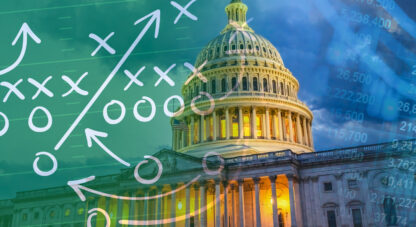Moment of Truth
Over the past two weeks, HAI has highlighted the incredibly important technical support zone between 3,900 and 4,000 on the S&P 500. This week, the market methodically tested numerous key moving averages and trendline support levels within this critical range. Given that fact, the S&P 500’s Friday melt-up, the recapturing of its 50-week moving average, and its weekly close well over 4,000 are initial indications that the retest of this crucial support zone has been successful.
That said, Friday’s rally had short covering characteristics as market participants were well hedged this week against a breakdown in prices associated with a possible failure to hold support. On Thursday and especially Friday, as support looked to hold, those hedges were largely covered. The effect of shedding downside protection en masse is to put upward pressure on markets. In a circular relationship, that upward pressure forces additional short covering, fuels squeeze dynamics, and stokes a rally that feeds on itself. This week’s successful retest of the 3,900–4,000 support zone was undoubtedly a very positive technical development for markets, but the final verdict on market direction will be determined by Jay Powell and the Federal Reserve.
When inflation data was in steady and consistent decline off of 2022 peak levels, hawkish Fed policy was assumed to be working. The Fed was raising interest rates at jumbo 75-basis point increments, Powell (invoking the name of Paul Volker) was claiming “unconditional” commitment to bringing inflation down to the 2% target, financial conditions were tightening, liquidity was drying up, and the Fed repeatedly insisted that it would not repeat the errors of the inflationary 1970s by prematurely loosening policy. All was well, and optimism was high on the frontlines of the Federal Reserve’s war on inflation. Markets broadly assumed that inflation would fall and the price of that fall would be recession. The question was how bad would things get—how low would markets go before inflation dropped sufficiently for the Fed to credibly pivot back to an easy, stimulative policy aimed at resuscitating the economy and reflating the financial system?
Then, in late September, the UK gilt market broke in a liquidity-induced market accident that threatened financial stability. The Bank of England was left as the “lender of last resort.” It was forced into a policy U-turn in which quantitative tightening plans submitted to a quantitative easing reality in order to restore confidence and functioning in the UK bond market. The lesson gleaned by global markets? Market accidents or a recession that threatens financial stability trump concerns over inflation, despite hawkish assertions to the contrary. The presumption of a protective Fed “put” became foremost again in the collective mind of the market, and the “unconditional” nature of the inflation fight was seriously called into question.
In rapid succession following the UK gilt crisis in late September, the surging dollar topped, Treasury yields rolled lower, market liquidity improved, and equity markets bottomed. In other words, financial conditions loosened considerably. The market narrative shifted toward expectations for a substantially more dovish Fed. Inflation was still falling consistently at the time. The combination of falling inflation and a more dovish expectation for Fed policy created a greater appetite for risk assets. The recent stock market Goldilocks moment was born.
The risk-on sentiment was further stoked by the Fed itself. After the UK gilt crisis, Powell’s Volker impersonation was notable by its absence, and the hawkish song Powell sang so convincingly in his August Jackson Hole manifesto proved little more than a one-hit-wonder. The Chairman’s uber hawkish rhetoric increasingly moderated, and he opted not to forcibly push back on the market’s (counterproductive with regard to inflation) loosening of financial conditions. In fact, he dismissed the idea that financial conditions had loosened at all, essentially endorsing the risk-on rally.
Most recently, while slowing the degree of interest rate increases to the minimum 25 basis points at the February 1st FOMC meeting, Powell boldly announced (in what was a mildly unseemly, certainly ill-timed, and clearly premature mini-victory-lap) that “the disinflation process has begun.” Immediately afterward, a slew of data releases indicated that inflation rates were reaccelerating higher again.
It all culminated in what economist Mohamad El-Erian this week dubbed the latest error in a “multistage policy error,” in which “the Fed first mischaracterized inflation as transitory for a protracted period, moved too slowly in adjusting policy once it ‘retired’ transitory from its vocabulary, and then fell behind the policy challenge for a third time by downshifting its [interest rate] increases too quickly from 75 to 50 to 25 basis points.”
As recent HAI’s have pointed out, when one pulls back and widens the lens, it’s clear that the Fed lost the narrative on hawkish policy follow-through in October. That wouldn’t have been a problem if inflation had continued lower. Unfortunately, that’s not what happened. The dramatic loosening in market-based financial conditions from October through early February sent a significant short-term demand impulse into the economy and re-stoked inflation data anew.
The new dynamic of reaccelerating inflation is hugely significant, and will soon be complicated by China’s Covid reopening. Concerns over the inflationary impact of a reopening China were bolstered this week by China’s February Manufacturing Purchasing Managers Index (PMI). From a low of 47 in December, China’s PMI jumped to a 52.6 reading in February. That marks the country’s strongest manufacturing reading since 2012. In addition, a separate report out of China showed home sales rising for the first time in 20 months after policymakers stepped up their support for the struggling sector. The surprising strength in Chinese data put a charge into commodity market prices as sudden expectations for stronger than anticipated Chinese goods demand upset precarious supply/demand dynamics in global commodity markets. Copper, aluminum, zinc, iron ore, and oil all traded higher following the Chinese data this week.
Importantly, the recent hot inflation data has already materialized without the contribution of a significant rally in commodities. The inflation uptick has, in fact, come from strength in services inputs to inflation in combination with a mere stabilization in commodity prices that had been falling until late 2022. At present, oil supply is set to tighten in the second half of 2023 and throughout 2024. Similarly, copper supply—currently at the highest levels seen in exchange monitored inventory levels in New York, London, and Shanghai since September of 2021—is poised to tighten in late Q2 and throughout the end of the year. If loose financial conditions in the US delay a recession and the expected associated demand destruction at the same time China’s reopening gains steam and drives greater than expected demand growth into a tightening supply outlook, commodity prices could rally and exacerbate reaccelerating inflation.
This weekend, the attention of commodity markets will be on the Chinese government and its “Two Sessions” gathering. There, Chinese officials will release a set of social and economic development goals, their official growth forecast, and the various policy measures to be implemented to achieve growth and further support an economic recovery.
Given the intense demand sensitivity of the commodity market that immediately impacts inflation, Fed policy is critical. If it is too loose, the Fed is playing with inflationary fire. As Warren Buffett says, “When the tide goes out, you get to see who’s swimming naked.” Well, in this case, the reacceleration of inflation is taking away the protective cover that transitory disinflation provided to hide recent Fed policy errors. If a full-fledged commodity rally gets going, insufficiently tight policy will be plain for all to see. The inflation fight will be right back to square one. As the tide of transitory disinflation recedes, the Fed will be outed as swimming naked, dangerously behind the curve, and woefully neglectful in the inflation fight.
This week, former Treasury Secretary Larry Summers conceded that, “A reasonable assessment of where the Fed is would say that they have not been this far behind the curve [on inflation] for a year or so.” That’s a devastating assessment. “A year or so” ago, inflation was surging and the Fed hadn’t even begun to lean into the fight. Summers added that Fed Chair Jerome Powell “has an important opportunity” next week (when he will be testifying on the economy in congressional hearings) “to reset expectations for the commitment and resolve of the Fed to the inflation fight and to address the growing credibility problems that the Fed has” after its reductions in rate-hike size and creating the expectation of a pause in the rate-hike cycle later this year even as inflation data reaccelerates. Powell will have a follow-up opportunity to demonstrate renewed inflation fighting resolve at the March 22 FOMC policy meeting.
What the recently reaccelerating inflation data makes clear, however, is that recession is an evil—but a necessary one for inflation to fall to the Fed’s 2% target. That reality will ultimately force the Fed to submit to a rather binary choice: 1) Reengage wholeheartedly in the inflation fight and pursue hawkish policy to whatever extent is necessary to bring about the recession needed to reduce inflation to target. 2) Allow loose financial conditions to persist, live with entrenched levels of higher inflation, and create a prolonged stagflationary crisis that could be even more painful than its 1970s predecessor.
Furthermore, with Fed institutional credibility hanging by a thread, failure on the part of the Fed to bring inflation down to the 2% target “unconditionally” risks inviting a devastating Austrian crack-up-boom dynamic. If the Fed continues to slow-walk the inflation fight in the face of reaccelerating data, markets will see clearly that the Fed no longer has the necessary will or policy flexibility to effectively control inflation with a monetary policy brake. At that point, either by design or by default, Ludwig Von Mises’ observation that “inflation is policy” will no longer be a deep suspicion long held by the “gold bug” minority, but a truth realized by all. Such a development would reveal that a market system formerly governed by the gold standard, then subsequently by the Fed standard, has digressed to the terminal stage of no standard. The unsettling fact is that when the majority consensus discovers “inflation is policy” in an unhinged “no-standard” market economy, “crack-up boom” risks become a devastating reality.
In the coming months we will learn which direction the Fed is headed. While the choices are narrow, the differing impacts to markets are wide. Regardless of which path the Fed chooses, markets will adjust quickly, substantially, and perhaps violently. While the long-term bullish trajectories are in little doubt for precious metals and select supply-constrained commodities, the short-term direction of almost all assets hangs in the balance—awaiting the Fed’s decision to accept inflation or aggressively reengage in the war against it.
Weekly performance: The S&P 500 was up 1.90%. Gold was higher by 2.06%, silver gained 1.43%, platinum jumped 7.88%, and palladium was up 5.12%. The HUI gold miners index was higher by 5.79%. The IFRA iShares US Infrastructure ETF gained 2.44%. Energy commodities were volatile and higher on the week. WTI crude oil was up 4.40%, and natural gas jumped 18.09%. The CRB Commodity Index was up 2.96%. Copper added 3.04%. The Dow Jones US Specialty Real Estate Investment Trust Index was up 2.30% on the week, while the Vanguard Utilities ETF (VPU) was down 0.62%. The dollar was down slightly by 0.21% to close at 104.94. The yield on the 10-yr Treasury gained 2 bps to end the week at 3.97%.
Best Regards,
Morgan Lewis
Investment Strategist & Co-Portfolio Manager
MWM LLC















